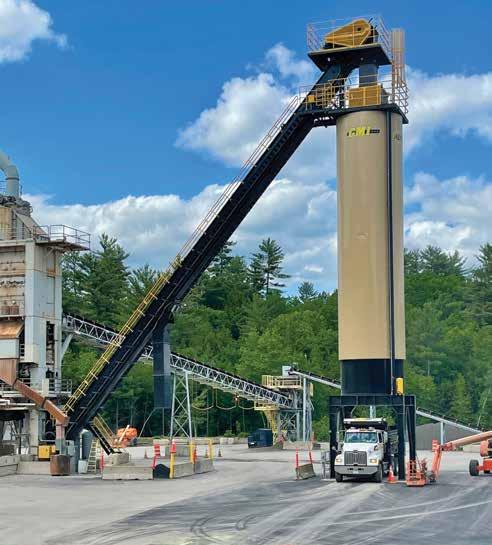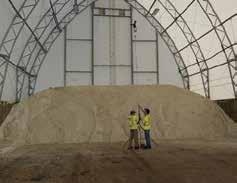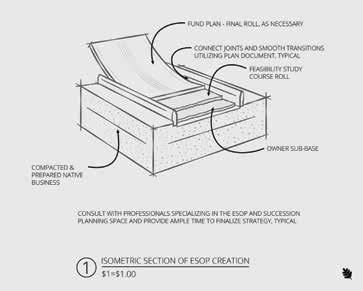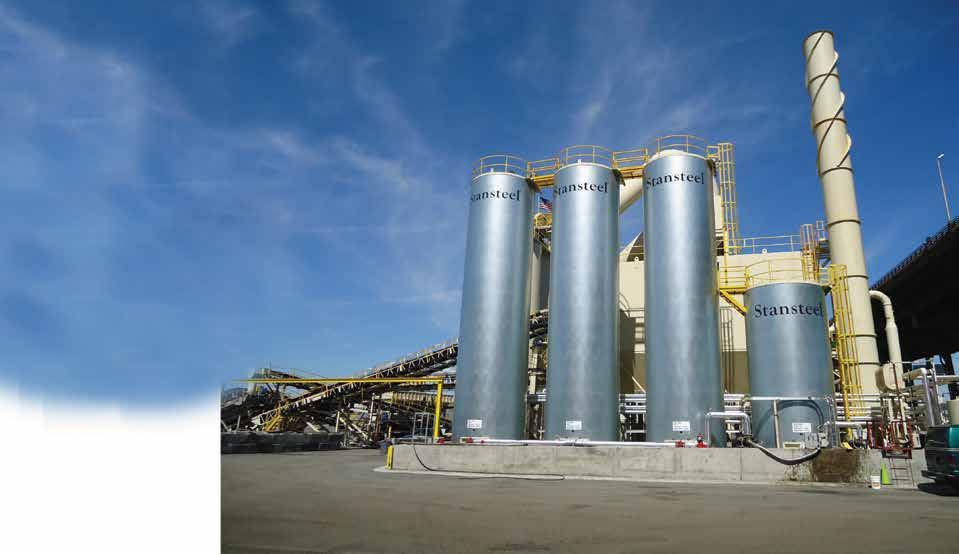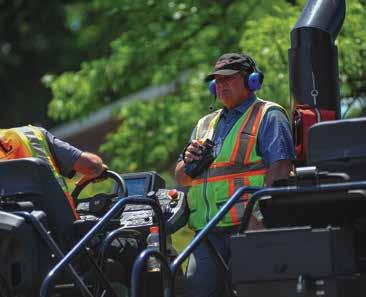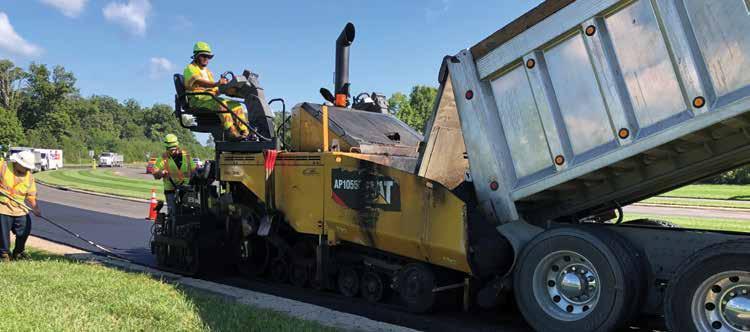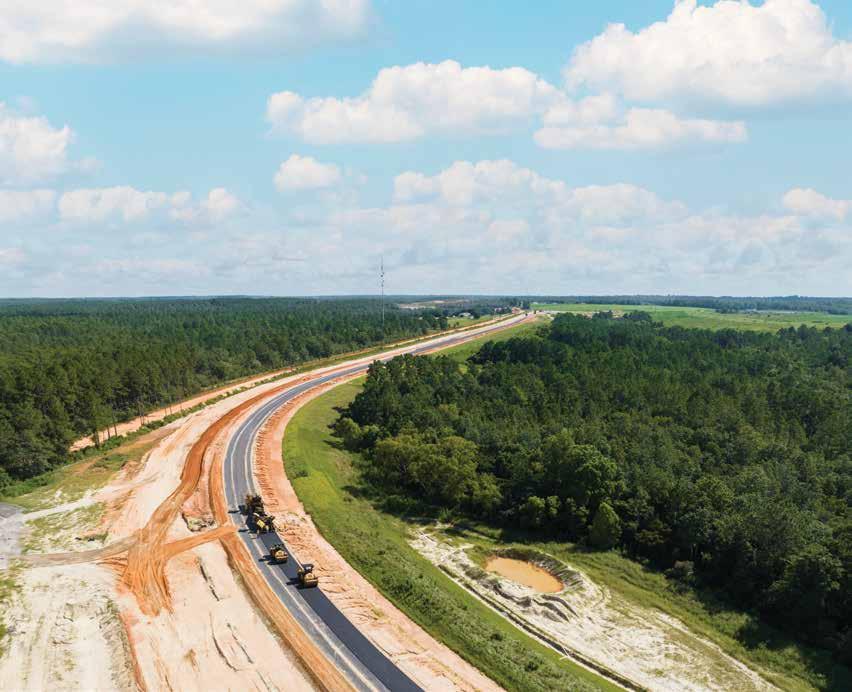
12 minute read
Advanced Energy Property Deployment
The skilled and well-trained operator lowers the environmental cost of operating the wheel loader with best practices, with optimum routes through the yard, with perfected bucket loading for least trips to and from stockpiles and cold feeds, with adequate lift to fill the right bins between bumpers, and so on. Good fuel economy equals money saved and emissions reduced. Photo courtesy of John Deere, Moline, Illinois
ADVANCED ENERGY ADVANCED ENERGY PROPERTY DEPLOYMENT PROPERTY DEPLOYMENT
PART 1:
Conceptualizing innovative GHG reduction via the DOE, IRS
OBY SANDY LENDER Owners of hot-mix asphalt (HMA) sites and quarries have the opportunity to not only upgrade existing facilities for best environmental performance, but also to receive government funding for a portion of the cost, according to information from a recent National Asphalt Pavement Association (NAPA) update. During a Sept. 8, 2022, member briefing, Jay Hansen, executive vice president—advocacy for NAPA, shared information about the $5.8 billion available through the Advanced Industrial Facilities Deployment Program, through which facilities owners can receive rebates of up to 50% of the cost to design and install advanced technology at their plants. This is merely one piece of the overall $369 billion pie that is supposed to drive down greenhouse gas (GHG) emissions to achieve a 40% reduction below 2005 levels by the year 2030. The program is run through the Department of Energy (DOE), and that is the entity to which an asphalt company owner will apply to receive a grant to upgrade or replace the plant.
Identifying and installing appropriate technology while applying for a government-embroiled grant to receive half the cost back may sound like a lot of effort to the average reader. The payoff is a more efficient operation that could more reliably hit your sustainability goals than current equipment, with money back. And, as Hansen stated during the Sept. 8 briefing, “If you’re not doing this, you can bet your competitors are.”
What is “this” that leaders among the asphalt industry should be looking into? We shared some grant-writing resources with the introductory article “Learn How to Write a Grant” for the plant product gallery department of the November 2022 edition of AsphaltPro. Next month, the January 2023 edition will look specifically at upgrading and updating the HMA plant with various advanced technologies. Right now, let’s dig a lit-
tle deeper into the concept for which the DOE had yet to provide specifics at press time, and for which the Internal Revenue Service (IRS) seemed to be seeking clarity during the month of October.
Oct. 7, the Department of the Treasury (Treasury Department) issued a “Request for Comments on Energy Security Tax Credits for Manufacturing Under Sections 48C and 45X.” Notice 2022-47's purpose, as explained in Section 1 of the official document, was to receive general and specific comments of questions the Treasury Department had prior to developing guidance for implementing and administering the two codes, which are part of the Inflation Reduction Act (IRA).
Keep in mind, the IRS request is looking at how to provide tax credits on qualifying technologies; the DOE will award grants based on its own set of qualifying technologies. The two will not necessarily be identical, although industry would be short-sighted to think they will not overlap. When speaking with NAPA’s Hansen, it became clear our industry has an opportunity to guide the categories of what is logically considered an advanced energy property designed to reduce GHGs, but our focus should be on partnering and avoiding a prescriptive list in any paradigm.
Hansen shared that the comments NAPA submits, on behalf of the asphalt industry, ahead of the Treasury Department’s Nov. 4 deadline, will reflect that the association supports the tax credit goal of re-equipping plants to achieve a 20% reduction in GHG emissions. “We don’t think listing out specific technologies is the way to go,” Hansen explained. “Rather, set the goal and let the manufacturers of asphalt mix deploy current technologies and develop future innovations to achieve the reduction. No one technology will get you there. It will require multiple combined technologies and some that have not yet been developed.”
Innovation is a hallmark of the asphalt industry, after all. Whether providing tax-reference guidance, grants or otherwise, the industry has a chance to work hand in hand with agencies that have yet to release any specifics.
“This is an opportunity for a new partnership,” Hansen said. “We don’t know what’s eligible for grant money yet. Will manufacturers of asphalt mix be able to apply for grants to reimburse installation of electric or solar charging stations? We don’t know yet.”
The Energy Security Tax Credits for Manufacturers was extended and expanded under the IRA. Specifically, Section 48C of the Internal Revenue Code, known as the “qualifying advanced energy project, provides a 30% investment tax credit on qualifying projects,” Hansen explained. “IRA was expanded to include a project that re-equips an industrial facility such as an asphalt plant with equipment that is designed to reduce GHG emissions by at least 20%. The IRS is seeking comments from the asphalt industry on how the credit should be applied.”
The request for comments offered an intriguing sense of latitude for asphalt plant owners who will write their future grant applications. The request referenced the IRA’s Section 48C(c)(1) (A)(ii), stating it adds to the list of eligible projects any project which installs low- or zero-carbon process heat systems, carbon capture, energy efficiency and any other technology designed to reduce GHG emissions.
The IRS sought guidance to define terms in that paragraph, of course, but also for how a qualifying advanced energy project would substantiate its eligibility for tax credits. In other words, how will the equipment, technology or advanced energy project prove its worth? That’s where cooperation among industry professionals must come in.

WINTER MAINTENANCE

www.tarmacinc.com
Is it TIME TO REPLACE YOUR WORN OUT CHAIN, FLIGHTS, FILTERBAGS, OR OTHER PARTS? CALL DALE. contact tarmac at 816-220-0700 or info@tarmacinc.com
WE’RE ALL IN THIS TOGETHER
“The federal government is the largest purchaser of construction materials,” Hansen said. “We’re on the cusp of innovation and we have to partner with the federal government, state transportation agencies and others to make it happen.”
We also must partner with one another. The top-of-mind example of industry working together is in the verified environmental product declaration (EPD) tool industry professionals and stakeholders assembled over years of data-mining, in conformance with ISO 14025 and EN 15804. NAPA’s website states these standards systems “establish principles and procedures for developing a Type III environmental declaration program and describing the potential environmental impacts of a product.”
EPDs for Idiots from 2019 = https://theasphaltpro.com/ label-asphalt-sustainable/ Eco-Emerald Label information with video = https:// www.asphaltpavement.org/programs/napa-programs/ emerald-eco-label
Another obvious example incorporates OEMs, their customers, and the vital collection and exchange of data—telematics.
Consider the use of training directors, heavy equipment distributors, and fleet operations managers who teach wheel loader operators best loading, stockpile management, cold feed delivery, and other practices. As Cat.com points out, fuel represents 50% of the cost to operate a machine; thus, you obviously want operators learning best practices to keep fuel use optimized.
The learned wheel loader operator lowers the environmental cost of operating the machine with best practices, with optimum routes through the yard, with perfected bucket loading for least trips to and from stockpiles and cold feeds, with adequate lift to fill the right bins between bumpers, and so on. The fuel economy is the amount of work he accomplishes per unit of fuel burned. To get good fuel economy is to save money, yes, but it’s also a way to lessen fuel expenditures and emissions.
The company owner isn’t just saving money by training wheel loader operators on best practices, but he’s also introducing good environmental practices to the operation in the yard. Is that training something he can put a dollar figure on? Is it something he can write into a grant or Energy Star Program application?
Where synergy and cooperation come into the fuel economy discussion starts with telematics. Copious fleet management software companies flood the AsphaltPro email inbox with article pitches to tell readers of their latest iteration to track equipment movement, fuel use, idle time, and so on. If your fleet is large enough, you might be saving enough on fuel use—through good tracking and best operator practices, thus tailpipe emissions—to warrant putting that on a grant application. You won’t know until you track it; the telematics provider is there to help.
Now let’s talk about the obvious GHG reduction zone of “heat,” and what cooperative effort is available to producers there. Even members of the Treasury Department can recognize the burner at the asphalt plant is an area where industry has made strides in reducing emissions in recent years. From implementing warm-mix asphalts (WMAs) that lower production temperatures—which should be worth grant money—to installing Lo-NOx and Ultra Lo-NOx burner technologies to manipulate combustion gases and burner flame, asphalt producers have already been finding ways to turn down the heat at the drum.
OEMs are willing to partner with customers to show how to reduce heat and emissions all around the tank farm and yard. Ron Herman, business development manager of Enerquip Thermal Solutions, Medford, Wisconsin, spoke of helping a customer find ways to reduce energy use for its U.S. Environmental Protection Agency’s (EPA) ENERGY STAR® industrial program goals.
“I’ll do the math for them,” Herman said. While his company doesn’t sell or install insulation packages for existing liquid asphalt tanks, he was willing to work on the equation to show a company how the 100,000 BTU/hour heating load increased by 25 times without insulation, making the “expense” of insulating a tank well worth its investment. “The savings on the utility bill alone pays for that in a season,” he said.
The researchers at Heatec Inc. (now Astec Industries) prepared Technical Paper T-140 “Heating and Storing Asphalt at HMA Plants,” which not only looked at the cost-per-unit of energy to heat liquid asphalt (and emulsions) but also discussed a heater’s thermal efficiency. The bottom line is a heater’s efficiency can change over its lifetime and that change in efficiency can influence how much energy is required to maintain temperatures.
The team at Process Heating Company (PHCo), Seattle, has more than 70 years of experience in manufacturing its Lo-Density® low-watt-density, drywell-style electric heating systems designed to spread heat over large surface areas. The researchers at PHCo state: “An electric-powered asphalt tank heater or hot oil heater...operates at 100% efficiency; there is no heat or emissions exhausted into the air. And over the lifetime of the heater, that efficiency never drops.” To help customers prove this, PHCo performed a fuel cost comparison of maintaining 30,000 gallons of liq-
LEARN MORE
States Get Started with Initiative Funds
The White House released a fact sheet Oct. 20 regarding a convening at the White House for “Buy Clean” commitments. The federal Buy Clean Initiative “leverages the Federal Government’s power as the largest purchaser in the world to advance low-carbon construction materials across its procurement and funded infrastructure projects,” according to the sheet.
Through the Initiative, the Department of Transportation announced that 25 states are receiving the first Federal Highway Administration (FHWA) Climate Challenge grants—to the tune of $7.1 million— to support sustainable pavements. The Department of Energy will coordinate Inflation Reduction Act funds for an Advanced Industrial Facilities Deployment Program. This will help industrial facilities retrofit, upgrade, or install industrial technologies and produce lowcarbon materials. More information can be read at the WhiteHouse.gov briefing room documents.
Those first 25 entities are Alabama DOT, Arizona DOT, Caltrans (three projects), Colorado DOT, State of Delaware DOT, State of Hawaii DOT, Illinois DOT, Indiana DOT, Iowa DOT, Louisiana DOT & Development, Maryland DOT and MD Port Administration, Minnesota DOT, Mississippi DOT, New Jersey DOT (two projects), New York State DOT, North Dakota DOT, Oklahoma DOT, State of Oregon DOT, Puerto Rico Highway and Transportation Authority, Rhode Island DOT, Texas DOT, Virginia DOT, West Virginia DOT Division of Highways, Washington DOT. Four local agency projects in the City of Seattle and in the Port of Authority of New York and New Jersey will receive technical assistance only.
uid AC at 300°F for 24 hours with natural gas, LP propane, No. 2 oil, No. 6 oil and electric at a heater’s “year 1” and at its projected year 8.
Check out PHCo’s “By the Numbers—Electric is Better” comparison chart at the company’s home page at processheating.com. There are dynamic fields where you can input your utility costs to calculate results.
Armed with actual figures, a company can plug everything from simple to complex technology into any number of green energy rating system program proposals such as an ENERGY STAR program or Institute for Sustainable Infrastructure (ISI) Envision® application. And the CFO can plug those numbers into a DOE Advanced Industrial Facilities Deployment Program grant proposal as well.
Enerquip’s Ron Herman had a host of ideas we’ll be sharing in the January equipment and technology installment of this article series, but here are basic “hot spots” he recommended customers look at for energy and money savings. • Replacing tank fire tubes with bottommounted tank coils, which removes an emissions source at each tank on the site • Addressing tank insulation, whether that’s repairing or installing • Repairing or replacing old hot oil heaters with new technology • Replacing boilers with hot oil heaters and steam generators • Going Lo-NOx or Ultra Lo-NOx on burners
Maybe the OEM you approach can share its scope 3 emissions to improve the upstream numbers you’re compiling. For example, the team at Honeywell, headquartered in Houston, has unveiled its ECOMAX® LE burner. The team developed it for furnace OEMs that need to meet tightening global nitrogen oxide emissions requirements and end users who want to increase fuel gas savings. The ECOMAX LE offers both flame and flameless operation, switching into flameless when a set temperature is reached, to deliver an average of 30% fuel gas savings compared to a typical cold air burner, according to the manufacturer.
With IRS seeking guidance and industry stakeholders willing to strategize alongside asphalt producers, it seems the asphalt industry is poised to take advantage of its innovative charge on The Road Forward. As Hansen pointed out, the DOE guidance on grants will be different from the guidance that ultimately comes from the Treasury Department, but our industry can hope that both offer guidance that sets a goal and is not prescriptive.
“The one difference may be that while the IRS tax credit is for re-equipping plants, the DOE grants might make plant replacement eligible,” Hansen said. When you consider the number of older facilities that have been replacing components or updating one aspect of the plant at a time, the idea of having $5.8 billion in grant money available to replace an entire plant with something exceedingly more efficient is mind-boggling. “This could be a big deal for the asphalt industry,” Hansen said.

